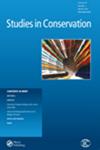Italian Influence in a Portuguese Mannerist Painting (Part I): A New Palette with Original Orange and Green Pigments
IF 0.8
4区 化学
0 ARCHAEOLOGY
引用次数: 1
Abstract
ABSTRACT The palette used by the Portuguese painter Pedro Nunes (1586–1637) in the large panel depicting The Descent from the Cross (460 × 304 cm) painted in 1620 for Évora’s cathedral was investigated with a combination of the visual inspection of the paint surface and the analysis of the paint layers with microscopic, spectroscopic, and chromatographic techniques. Green earth and an orange artificial arsenic sulphide, two pigments identified for the first time in Portuguese paintings of the sixteenth and seventeenth centuries, were found to be abundantly used in large areas of the composition. The results further reveal the choice of a rich palette also containing lead-white, lead-tin yellow, ochre, vermilion, verdigris, smalt, azurite, vegetable carbon black, and a red lake made of brazilwood and cochineal. All the pigments were bound in an oil-based medium. The introduction of two pigments new to the Portuguese conventional palette is a direct consequence of the painter’s training in Rome in the first decade of the seventeenth century.意大利对葡萄牙风格主义绘画的影响(上):橙色和绿色颜料的新调色板
摘要葡萄牙画家佩德罗·努涅斯(1586-1637)在描绘《十字架的后裔》(460 × 304 1620年为埃沃拉大教堂绘制的),结合对油漆表面的目视检查和使用显微镜、光谱和色谱技术对油漆层的分析进行了研究。16世纪和17世纪葡萄牙绘画中首次发现的两种颜料——绿色泥土和橙色人造硫化砷,被发现在作品的大面积使用。结果进一步揭示了丰富的调色板的选择,其中还包括铅白色、铅锡黄色、赭石、朱红色、铜绿、斯马特、天青石、植物炭黑,以及由巴西木和胭脂虫制成的红色湖泊。所有颜料都结合在油基介质中。葡萄牙传统调色板中引入了两种新颜料,这是17世纪前十年画家在罗马接受训练的直接结果。
本文章由计算机程序翻译,如有差异,请以英文原文为准。
求助全文
约1分钟内获得全文
求助全文
来源期刊

Studies in Conservation
化学-分析化学
CiteScore
1.80
自引率
12.50%
发文量
73
审稿时长
>12 weeks
期刊介绍:
Studies in Conservation is the premier international peer-reviewed journal for the conservation of historic and artistic works. The intended readership includes the conservation professional in the broadest sense of the term: practising conservators of all types of object, conservation, heritage and museum scientists, collection or conservation managers, teachers and students of conservation, and academic researchers in the subject areas of arts, archaeology, the built heritage, materials history, art technological research and material culture.
Studies in Conservation publishes original work on a range of subjects including, but not limited to, examination methods for works of art, new research in the analysis of artistic materials, mechanisms of deterioration, advances in conservation practice, novel methods of treatment, conservation issues in display and storage, preventive conservation, issues of collection care, conservation history and ethics, and the history of materials and technological processes. Scientific content is not necessary, and the editors encourage the submission of practical articles, review papers, position papers on best practice and the philosophy and ethics of collecting and preservation, to help maintain the traditional balance of the journal. Whatever the subject matter, accounts of routine procedures are not accepted, except where these lead to results that are sufficiently novel and/or significant to be of general interest.
 求助内容:
求助内容: 应助结果提醒方式:
应助结果提醒方式:


